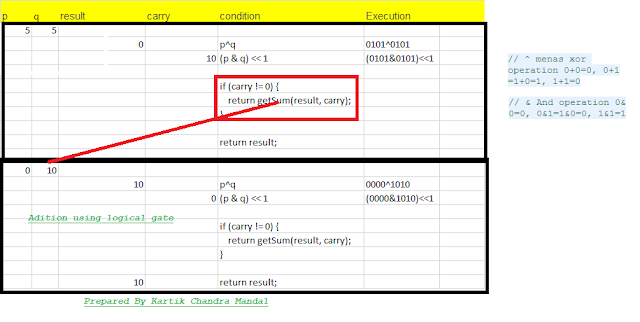| Description: |
This is multiple way do the Addition and subtraction . But mainly focusing on Booth's Algorithms' and recursive methods.
N.B : For Subtraction: So when we do the subtraction then first convert to 2's complement of sub-tractor after then call recursive method itself recursive.
a = 5 = 0101 (In Binary) Bitwise Compliment Operation of 5 ~ 0101 ________ 1010 = 10 (In decimal)
Note – Compiler will give 2’s complement of that number, i.e., 2’s compliment of 10 will be -6.
5.Left shift operator (<<) –Shifts the bits of the number to the left and fills 0 on voids left as a result. Similar effect as of multiplying the number with some power of two. For example, a = 5 = 0000 0101 b = -10 = 1111 0110 a << 1 = 0000 1010 = 10 a << 2 = 0001 0100 = 20 b << 1 = 0000 1010 = -20 b << 2 = 0001 0100 = -40 6.Signed Right shift operator (>>) – Shifts the bits of the number to the right and fills 0 on voids left as a result. The leftmost bit depends on the sign of initial number. Similar effect as of dividing the number with some power of two. For example, a = 5 = 0000 0101 b = 10 = 0000 1010 (takes 2's compliment) b = -10 = 1111 0110 b >> 1 = 1111 1011 = -5 b >> 2 = 1111 1101 (takes 2's compliment) = -3 |
Example: 1101 and -1001 First, find the 2's complement of the negative number 1001. So, for finding 2's complement, change all 0 to 1 and all 1 to 0 or find the 1's complement of the number 1001. The 1's complement of the number 1001 is 0110, and add 1 to the LSB of the result 0110. So the 2's complement of number 1001 is 0110+1=0111 Add both the numbers, i.e., 1101 and 0111; 1101+0111=1 0100 By adding both numbers, we get the end-around carry 1. We discard the end-around carry. So, the addition of both numbers is 0100. Case 2: Adding of the positive value with a negative value when the negative number has a higher magnitude. Initially, add a positive value with the 2's complement value of the negative number. Here, no end-around carry is found. So, we take the 2's complement of the result to get the final result. Example: 1101 and -1110 First, find the 2's complement of the negative number 1110. So, for finding 2's complement, add 1 to the LSB of its 1's complement value 0001. 0001+1=0010 Add both the numbers, i.e., 1101 and 0010; 1101+0010= 1111 Find the 2's complement of the result 1110 that is the final result. So, the 2's complement of the result 1110 is 0001, and add a negative sign before the number so that we can identify that it is a negative number. |
| Code 1: |
package com.kartik;
/**
*
* @author kartik
* Blog java2blogs.blogspot.com
* This is multiple way addition algorithm. Mainly focusing on Booth's algorithms
*/
public class AdditionAndSubtraction { public static int getSum(int p, int q) { int result = p ^ q; // + without carry 0+0=0, 0+1=1+0=1, 1+1=0 int carry = (p & q) << 1; // 1+1=2 if (carry != 0) { return getSum(result, carry); } return result; } public static int subtract(int n1, int n2){ // Add two's complement and return. return getSum(n1, getSum(~n2, 1)); } public static void main(String[] args) { int i=10; int j=12; int r=getSum(i,j); System.out.println(r); int r1=subtract(j,i); System.out.println(r1); } } |
| Example 1 Addition and subtraction: |
